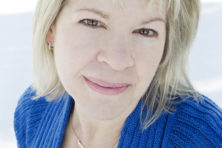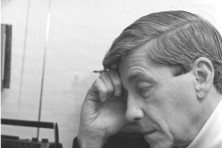Q&A with the 2019 Hal Prize Judges
- Share
- Tweet
- Pin
- Share
We had the opportunity to talk with the 2019 judges for the Hal Prize in Literature and Photography – Tytia Habing (photography), Cynthia Swanson (fiction), Ira Sukrungruang (poetry) and Thomas Pecore Weso (nonfiction) – about their art.
Peninsula Pulse (PP): When did you know you wanted to be a writer or photographer?

Cynthia Swanson (CS): I can’t remember not wanting to be a writer. I wrote as a kid, through my teen years, and into adulthood. I did take a detour in college to major in architecture for two years. I still love design, but architecture didn’t last as a major (or a career) because I couldn’t deny that writing is my true passion.

Ira Sukrungruang (IS): I don’t think I remember a precise age. I remember a moment. That’s the funny way memory works – not by numbers, but by moments. And the moment I remember is the boy I was coming down late at night, past bedtime, to finish reading Charlotte’s Web by E.B. White. It was an urgent need. An obsession that needed satiating. I sat in a cushioned chair that devoured me and read until the end. And I remember crying. I remember the story having this wondrous and sad effect on me. That it could open doors, lives, minds. So that moment was the gateway to a life and love of reading. The act of writing came later, but still, once you read a good book, once you become a reader, you, in many ways, begin writing also. The imagination awakens. The brain churns out images, and images transform into language. So even if it wasn’t on paper yet, the writing was happening.
PP: What themes do you explore in your work?

Tytia Habing (TH): I focus on my family and the Midwest, with nature being the cohesive thread that ties it all together. I’ve recently begun exploring the interconnectedness of people, the world and the universe, and have started new projects on this theme.

Thomas Pecore Weso (TW): I love to cook, so food is a big focus in my memoirs, and I use recipes in every chapter of my award-winning Good Seeds: A Menominee Food Memoir. Like most Native people, I write about the land around me in many ways, and also family and friends.
IS: Too many! But the ones I come back to in all my work: what it means to be an immigrant son, to occupy a big body. Both deal with belonging. I also write about what is home and the intricacies of identity. Lately, however, everything is revolving around fatherhood, grief, loss and time. It’s because I’m chasing a toddler around and thinking about the future and what it holds and all the fears I have and the joys I hope for.
PP: When reviewing work – whether for a contest such as the Hal Prize, students’ work, or other – what do you look for? What excites you most?
CS: In my own work and that of other writers, I look for a combination of compelling plot and well-developed characters. I think this is possible even in genre fiction. The Glass Forest, for example, is suspense, but the story is character-driven. I gravitate toward writing that makes me think and that lingers in my mind after I’ve read the final word.
TH: First and foremost, I like to see a person’s unique view of their life and other views of the world. After that, I’ll look at composition and technical aspects of the image, but a unique viewpoint is by far the most important. I don’t necessarily gravitate toward work that looks like mine. I like to see different viewpoints as well as different formats and styles of photography. I think the key to a successful photographer is to show who they are and what they have to say. Everyone’s life is different and interesting to others, and a unique viewpoint is a photographer’s biggest advantage.
TW: When I read through the entries for the first time, I will look for basics. Is this the right category? Is there coherence? Are there good, readable sentences? Is there a clear subject matter? All the entries that pass this first reading go into a pile for a second reading. Then I will look for stories that blow the top of my head off, or, as Emily Dickinson wrote about poetry, “If I feel physically as if the top of my head were taken off, I know that is poetry.” I need to be moved.
PP: What advice would you give to aspiring writers and artists?
CS: Read voraciously – in your own genre and in others. Learn to read with a critical eye. What do you like, and why? What works, and what doesn’t? When writing, I’m a big believer in letting first drafts be whatever they’re going to be, and then doing a lot of revision. One of my favorite writing quotes is from Jodi Picoult: “You might not write well every day, but you can always edit a bad page. You can’t edit a blank page.”
IS: Don’t fear failure. It’s how you come back from failure that is a true testament of the artist.
PP: What writers or photographers most influenced you and why?
TH: I’m influenced by so many artists, not just photographers. I love musicians, crafters, potters, you name it. One artist I’m particularly inspired by is Ashley Longshore, a painter in New Orleans. She’s very outspoken; she’s hilarious; and her paintings are super colorful, and they all have a message. She’s also a champion for all artists. She wants all artists to make it, not to take any crap and, most importantly, to be paid appropriately. If you’re an artist, you should be following her. She has a lot of relevant things to say that affect all artists, and she’s a positive cheerleader.
TW: I wrote my master’s thesis on Leslie Marmon Silko’s novel Ceremony. Her ability to write about contemporary Pueblo Indian life in terms of her tradition inspires me. Also, there is much lore about plants. My memoir uses Silko as a model in some ways, even though hers is supposedly fiction.
PP: How do you know when a piece of work is finished and ready to go out into the world?
IS: I never really know whether I’m done with a piece. It’s more of a feeling. Or the idea that I’ve done all I could do, examined it from all angles. But even when the piece is sent out or has been published, there’s always a doubt. When I read things I’ve written in the past, sometimes I say to myself, I wish I would’ve done that differently.
PP: Is there one book you think every American should read and why? Or one photographer everyone should be familiar with and why?
TH: I’ll say Aline Smithson. Not only is she a wonderful photographer, but her use of color is out of this world, and she’s also a wonderful person. She’s helped me navigate through the photography world on many occasions. She teaches workshops; she’s a juror for many shows and contests; and she started Lenscratch, which is an online photography resource all photographers should know about.
TW: The U.S. Constitution – so we all appreciate equal rights under the law.
IS: I think all Americans should read books outside of America to see how the rest of the world works. We’ve created a sort of bubble for ourselves. So, Hong Kong writer Dorothy Tse, or South African writer J.M. Coetzee, or Indian Arundhati Roy, to name a few.CS: I can’t name a singular book because reading is a personal and subjective experience. I would advise anyone – whether a writer or not – to read regularly and read widely. If you have kids in your life, read to them, and give them books. The written word opens up entire worlds that we might otherwise never experience. It goes a long way toward helping us understand one another.




